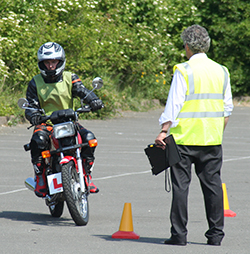21st December 2010
 The Minister for Road Safety Mike Penning from the Department for Transport (DfT) in Great Britain has stated that the DfT intends to review the two part motorcycle test and to trial a new, single, on-road motorcycle test.
The Minister for Road Safety Mike Penning from the Department for Transport (DfT) in Great Britain has stated that the DfT intends to review the two part motorcycle test and to trial a new, single, on-road motorcycle test.
The announced motorcycle test review and subsequent report is the result of work the Department has undertaken with motorcycle groups, training organisations and others since June 2010. This is on the back of another report by the Parliamentary Transport Select Committee (TSC) which was the result of a short enquiry which took place in October 2009 in the House of Commons.
This “European” test was introduced in Northern Ireland in December 2008 and in April 2009 in the rest of the UK . Its aim was to improve road safety.
The test employs two practical elements: one consists of technical exercises off-road, designed to assess the rider’s ability to control the machine safely (including a swerve and brake manoeuvre).
These elements are tested at designated Multi Purpose Test Centres (MPTCs). The other element is a road-based test of traffic handling skills on the public highway.
Those concerned since the proposed introduction of this two part test (and in fact even after the UK Government got an extension from Europe before its introduction in the UK) have been blue in the face telling Government of their concerns of their approach.
Mike Penning said: “I want to make sure that we have a test which prepares bikers properly for the road so the motorcycle test review is a top priority for me. My goal has always been a single, on-road test which is rigorous and reflects real-life conditions. By working with the motorcycle training industry and others we have identified a set of changes which have the potential to deliver this”. Adding, “It is also my aim that these changes will open up the test to those living in areas which are poorly served by the current network of-off road test centres”.
The report suggests a new hazard avoidance manoeuvre which – subject to further trialling – could be carried out on the road. There is also a proposal which will be given further consideration, that slow manoeuvres such as slalom, figure of eight, and U turn could be examined at training centres by delegated examiners ahead of the main test. The next step will be to hold wider trials, with test-level candidates, in the New Year. This process will be followed by public consultation on the proposed changes.
The DfT hopes, subject to further work on safety, cost and value for money, that there would be a phased introduction of on-road testing moving to general adoption of the new test by the end of 2011 or early 2012. This will include on-road testing in priority areas which are poorly served by the current network of off road test centres.
So after allegedly spending £77 million in the wake of the introduction of the test, a “friendly” minister who appears to be listening, will trial the proposed new manoeuvres, in the early part of 2011, followed by public consultation on the proposed changes, secondary legislation governing the test to be amended, examiners and trainers to prepare for the new test and on road sites to be identified and prepared the rest of the UK will get what has been asked for all along.
Meanwhile in Northern Ireland the test regime here is not included in the review, with the forthcoming introduction of CBT to bring Northern Ireland in line with licensing and testing in Great Britain. We can only hope that the agencies responsible here will examine the results of the DfT review with interest and evaluate the possible impacts on Northern Ireland accordingly.
DfT Test Review – Click Here ![]()



Speak Your Mind